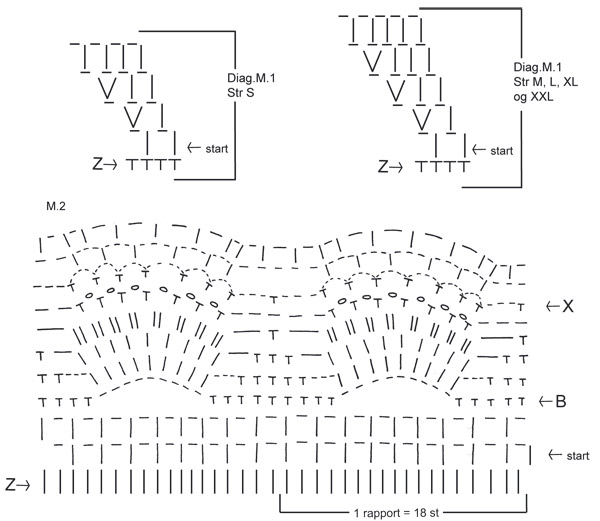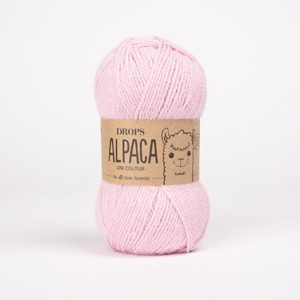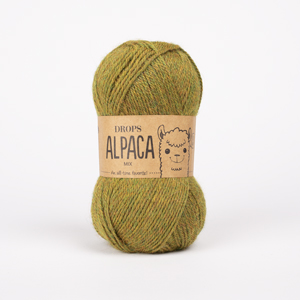Comments / Questions (180)
![]() Dorte wrote:
Dorte wrote:
Hej. Når jeg hækler det runde bærestykke, kan jeg umuligt få en lige samling nedad hvor omg. startes/sluttes. Er det meningen at arbejdet skal "dreje" mod venstre?
15.06.2025 - 13:03DROPS Design answered:
Hej Dorte, her ser du hvordan man kan gøre for at undgå at det trækker skævt: Hækle rundt
17.06.2025 - 08:21
![]() Lynn wrote:
Lynn wrote:
In the row below the X, I’m confused how to start the beginning 3ch, and join the ending 2ch. The 5ch between repeats does not attach to anything below. I hope this makes sense.
02.05.2025 - 05:35DROPS Design answered:
Dear Lynn, start this row with 1 chain and end with 1 slip stitch in this chain to connect first and last chain space. Happy crocheting!
02.05.2025 - 08:55
![]() Mónica wrote:
Mónica wrote:
Hola en M.2 en la tercer hilera contando desde B hay una línea recta que va desde el pb hasta el pba, es más larga que el grafismo del p de cad, y no está en ninguna de las explicaciones de los modelos que usan este diagrama, me podrían decir a que punto corresponde? Muchas gracias
14.01.2024 - 21:56DROPS Design answered:
Hola Mónica, se trata de 1 p.de cad; debido a la representación en papel del resto del diagrama se ha tenido que dibujar más alargado de lo habitual.
14.01.2024 - 23:25
![]() Debbie McPeak wrote:
Debbie McPeak wrote:
Is there any way to have the pattern instructions written in a format that is easy to understand? I love this and want to make it but it's very confusing.
21.05.2023 - 16:34DROPS Design answered:
Dear Debbie, this is the only format of the pattern available. If you have trouble understanding crochet charts, you can check the following lesson: https://www.garnstudio.com/lesson.php?id=69&cid=19. For any specific parts of the pattern, you can ask us here and we'll try to explain it in another way. Happy crocheting!
21.05.2023 - 18:02
![]() Luna wrote:
Luna wrote:
Hallo, muss ich in den Diagrammen M1 und M2 IMMER nach 1Stb, 1fM eine Masche überspringen oder ist das nur jeweils in der ersten Runde so, bzw in M2 in der 1. und 2. Runde so?
30.09.2022 - 07:15DROPS Design answered:
Liebe Luna, es wird nur bei der 1. Reihe in M.1 bzw M.2 eine Masche übersprungen (aber durch eine Luftmasche ersetzt), dann häkeln Sie wie im Diagram gezeigt. Viel Spaß beim häkeln!
30.09.2022 - 08:29
![]() InfiernoC wrote:
InfiernoC wrote:
Hallo, zur Frage davor, leider beantwortet Ihre Antwort nicht meine Frage, in dem Diagramm M1 erkenne ich nicht, dass ich eine fM überspringen soll, ergo weiß ich auch nicht, ob in M2 ebenfalls fM übersprungen werden müssen, woran erkenne ich dieses? In M1 erkenn ich nicht, warum in R1 eine fM übersprungen werden soll und in R2 nicht.
20.09.2022 - 10:45DROPS Design answered:
Liebe InfiernoC, bei der 1. Reihe (mit dem Pfeil "Start") in M.1 häkeln Sie über 4 fM so: (1 Stb in das erste/nächste fM, 1 Lm, 1 fM überspringen, 1 Stb in das nächste fM, 1 Lm, 1 fM überspringen) wiederholen Sie von (bis) - und in M.2 wird es genauso gehäkelt 1 Stb in das erste Stb, *1 Lm, 1 M überspringen, 1 Stb in das nächste Stb*, von *-* wiederholen und Ende beenndet mit 1 Lm, 1 M überspringen, 1 Km. Kann das Ihnen helfen?
21.09.2022 - 08:53
![]() InfiernoC wrote:
InfiernoC wrote:
Hallo, in Ihrem Kommentar vom 23.02.2014 schreiben Sie, dass in dem Diagramm M1 in der 1. Rd 1fM übersprungen werden soll. Wie erkenne ich das in dem Diagramm, wann ich eine fM überspringen soll? Danke schon mal vorab
20.09.2022 - 07:17DROPS Design answered:
Liebe InfiernoC, also ja, stimmt schon, in M.1, S häkeln Sie *1 Stb, 1 Lm, 1 Masche Überspringen, 1 Stb, 1 Lm, 1 Masche überspringen*, aber in die 2. Reihe häkeln Sie: *1 Stb um die Lm, 1 Lm, (1 Stb, 1 LM, 1 Stb um die nächste Lm, 1 Lm)*, hoffentlich kann das Ihnen helfen. Viel Spaß beim häkeln!
20.09.2022 - 10:07
![]() InfiernoC wrote:
InfiernoC wrote:
Hallo, ich verstehe dass Muster M1 nicht richtig. Über dem V ist noch ein Strich, sind das 2 verschiedene Reihen oder wie ist das zu lesen?
18.09.2022 - 20:43DROPS Design answered:
Liebe InfiernoC, jedes Symbol steht für eine Masche, dh über (1 Stb, 1 LuftMasche, 1 Stb) häkeln Sie bei der nächsten Reihe (1 Stb, 1 Luftmasche, 1 Stb, 1 Luftmasche). Viel Spaß beim häkeln!
19.09.2022 - 10:52
![]() Toñi wrote:
Toñi wrote:
Cuando pone: Tip para los aumentos 3: para aum 1 arco: trabajar 2 arcos en el mismo punto. Que significa? Lo podría explicar? Gracias.
11.07.2022 - 23:08DROPS Design answered:
Hola Toñi, para aum 1 arco trabajas 2 p.de cad, 1 p.b en el mismo pt (=1 arco), 2 p.de cad, 1 p.b en el mismo punto (= 2º arco).
13.07.2022 - 11:49
![]() Sue wrote:
Sue wrote:
After making 8 right-sleeve chains, the ch-loops to the 8 left-sleeve chains, followed by ch-loops back to the right sleeve, the rows become 1 continuous row that keeps winding around the garment. After the 8 left-sleeve chains, following ch-loops, should I slip stitch the ch1 from the last ch-loop, to the 1st right-sleeve ch8 and make 3 chains to replace the first dc, to start a new row? Or, do I ch-loop in the 8 right-sleeve chains and ch-loops for 1 continuous row around the garment?
21.06.2022 - 07:40DROPS Design answered:
Dear Sue, after dividing yoke for body and sleeve work the 8 chains mid under arms in pattern as before so that pattern will continue in the round as before - you should have 6 ch-spaces under each sleeve. Happy crocheting!
21.06.2022 - 09:42
Breath of Summer#breathofsummertunic |
||||||||||||||||||||||
|
|
||||||||||||||||||||||
Crochet DROPS tunic with mussel pattern with 1 thread Alpaca and 1 thread Cotton Viscose or Bomull-Lin. Size S - XXL
DROPS 99-4 |
||||||||||||||||||||||
|
Crochet gauge: 12 dc x 7 rows with 1 thread Alpaca and 1 thread Cotton Vicose or 1 thread Bomull-Lin = 10 x 10 cm [4" x 4"]. 1 repeat of mussel pattern = width approx 12 cm [4¾"]. Increasing tip 1: To inc 1 sc: crochet 2 sc in 1 sc. Increasing tip 2: To inc 1 dc: crochet 2 dc in 1 dc (no ch in between). Increasing tip 3: To inc 1 ch-loop: crochet 2 ch-loops in the same st. Crochet info: At the beg of each round replace the first dc with 3 ch. Replace first tr with 4 ch. Finish each round with 1 sl st in 3rd/4th ch from beg of round. Pattern: See chart M.1 and M.2. The charts are seen from the RS. Measuring tip: Because of the weight of the wool all measurements should be made whilst the garment is hanging. TUNIC Back and front piece: The tunic is crochet in the round from the top down. Loosely crochet 71-75-75-79-83 ch on crochet hook size 5 mm [H/8] with 1 thread Drops Alpaca and 1 thread Drops Cotton Viscose (double thread) or 1 thread Bomull-Lin. Form a ring with a sl st in the first ch. Crochet next round as follows: 1 sc in each of the first 3 ch, *skip 1 ch, 1 sc in each of the 3 next ch*, repeat from *-* = 54-57-57-60-63 sc. Now crochet a round of sc, at the same time inc 22-15-19-20-21 sc evenly – see Increasing tip 1 = 76-72-76-80-84 sc. Continue in chart M.1 – see Crochet info. After M.1 there are 76-90-95-100-105 ch-loops on round (1 ch-loop = 1 dc + 1 ch). Continue with dc in ch and ch over dc until piece measures 10-11-12-13-14 cm [4"-4⅜"-4¾"-5⅛"-5½"]. Crochet next round as follows: Skip 17-19-21-22-22 ch-loops from previous round (= right sleeve), crochet 8 ch (= under arm), crochet 21-26-26-28-30 ch-loops (= front piece), skip 17-19-21-22-22 ch-loops from previous round (= left sleeve), crochet 8 ch (= under arm), crochet 21-26-27-28-31 ch-loops (= back piece). Place a marker each side, in between the 8 ch crochet mid under arm. Continue in ch-loops. Note! On the first round crochet the 8 ch under each arm as follows: 1 dc in the first ch, 1 ch, skip 1 ch, 1 dc in next ch, 1 ch, 1 dc in the same ch, 1 ch, skip 1 ch, 1 dc in next ch, 1 ch, 1 dc in the same ch, 1 ch, skip 1 ch, 1 dc in next ch, 1 ch and skip 1 ch (= 6 ch-loops under each arm) = 54-64-65-68-73 ch-loops on round in total. Continue in ch-loops in the round, at the same time inc 1 ch-loop – see Increasing tip 3 – on each side of both markers on every round a total of 4-4-6-6-7 times = 70-80-89-92-101 ch-loops. After all inc piece measures approx 19-20-23-24-27 cm [7½"-8"-9"-9½"-10⅝"] measured from ch-chain at neckline (you have now reached mid chest; if you wish to adjust this crochet additional rounds in ch-loops after the inc). Now crochet 1 round in ch-loops, at the same time inc 4-2-2-14-14 dc evenly on round – see Increasing tip 2 = 144-162-180-198-216 dc/ch. Now continue in mussel pattern chart M.2 (beg at start arrow in diagram) = 8-9-10-11-12 horizontal repeats on round. Crochet 3 vertical repeats of M.2, but beg the second and third repeat by the Arrow-B in diagram. After M.2 crochet 2-3-3-3-4 rounds in tr as follows: Round 1: Remember crochet info! Crochet 1 tr in each ch-loop with 1 ch in between each and finish with 1 tr in the last dc = 72-81-90-99-108 tr. Round 2: crochet 1 tr in each tr from previous round with 2 ch in between each tr (instead of 1) – finish size S here before the last mussel pattern = 72 tr. Round 3: crochet 1 tr in each tr from previous round with 3 ch between each tr - finish size M, L and XL here before the last mussel pattern = 81-90-99 tr. Round 4: crochet 1 tr in each tr from previous round with 3 ch between each tr - finish size XXL here before the last mussel pattern = 108 tr. Now crochet a round in ch-loops as follows: 1 dc and 1 ch (= 1 ch-loop) in each tr from previous round, at the same time inc 1 ch-loop – see Increasing tip 3 – in every 3-3-4-4-4 tr. Note! For size L and XL finish with 1 dc and 1 ch in each of the last 2-3 tr = 96-108-112-123-135 ch-loops. Continue with 1 round of ch-loops, at the same time inc 6-0-10-6-0 dc – see Increasing tip 2 = 198-216-234-252-270 dc/ch. Now crochet M.2 again (beg at start arrow in diagram), but finish the pattern after row 7. |
||||||||||||||||||||||
Diagram explanations |
||||||||||||||||||||||
|
||||||||||||||||||||||

|
||||||||||||||||||||||

|
||||||||||||||||||||||
Have you finished this pattern?Tag your pictures with #dropspattern #breathofsummertunic or submit them to the #dropsfan gallery. Do you need help with this pattern?You'll find 7 tutorial videos, a Comments/Questions area and more by visiting the pattern on garnstudio.com. © 1982-2025 DROPS Design A/S. We reserve all rights. This document, including all its sub-sections, has copyrights. Read more about what you can do with our patterns at the bottom of each pattern on our site. |
||||||||||||||||||||||
















































Post a comment to pattern DROPS 99-4
We would love to hear what you have to say about this pattern!
If you want to leave a question, please make sure you select the correct category in the form below, to speed up the answering process. Required fields are marked *.